Purple basil: planting and care
Despite the variety of types and varieties of basil, summer residents often prefer purple. The plant is characterized by a dark color of leaves, a spicy but mild aroma and a sharper flavor than that of green. In addition to vitamins and minerals, purple basil contains anthocyanins - flavonoids with antioxidant properties. Let's describe in detail the cultivation of this crop.
The content of the article
Growing purple basil seedlings from seeds
Sowing seeds directly into open ground is allowed... The optimal time for this in the southern regions is mid - end of April, in other regions due to the risk of return frosts - the end of May - June.
To protect seedlings from frost and speed up the harvestBasil is grown in seedlings. In this case, the seeds are germinated at home, and then the grown and matured seedlings are transplanted to the beds.
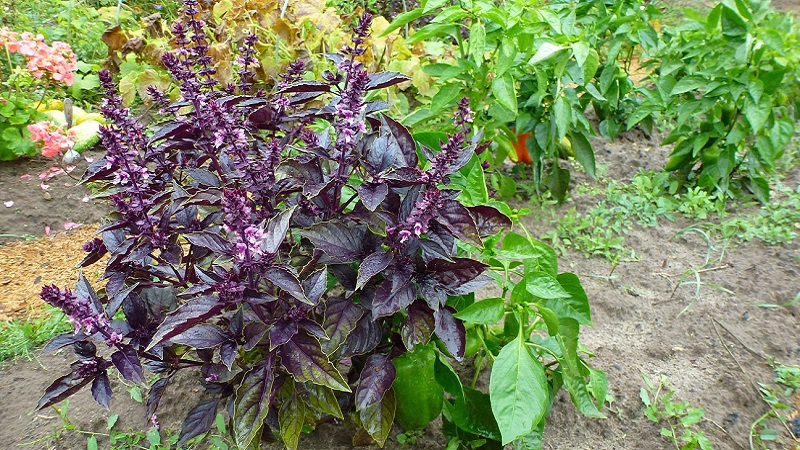
When to sow
By defining sowing time for seedlings, are guided by the fact that plants are transferred to open ground no earlier than at the age of 45-60 days. In all regions, except for the southern ones, where sowing is carried out immediately in open ground, the optimal time for this is the end of March - beginning of April.
Seed preparation
One of the main conditions for the successful cultivation of basil is the correct preparation of the planting material., since the etheric coat of seeds makes it difficult for them to germinate. Pelleted grains do not require pre-sowing treatment.
For 10-15 days before sowing, the seeds are kept in a well-heated place... Most often they are placed on a battery, wrapped in natural fabric.
After warming up the seeds are soaked in warm water: laid out on gauze, tied with a thread and placed in a container with hot water (+ 40 ° C). They are placed in a warm place for 1-2 days, the water is changed every 12 hours. After that, the gauze bag is gently washed with water to wash off the mucus from the seeds, and dried.
Reference. If the material was collected independently, before sowing, it is soaked for 1 day in a solution of potassium permanganate in order to disinfect and improve resistance to diseases and pests.
To improve root formation the seeds are dipped for 1 hour in the Kornevin solution.
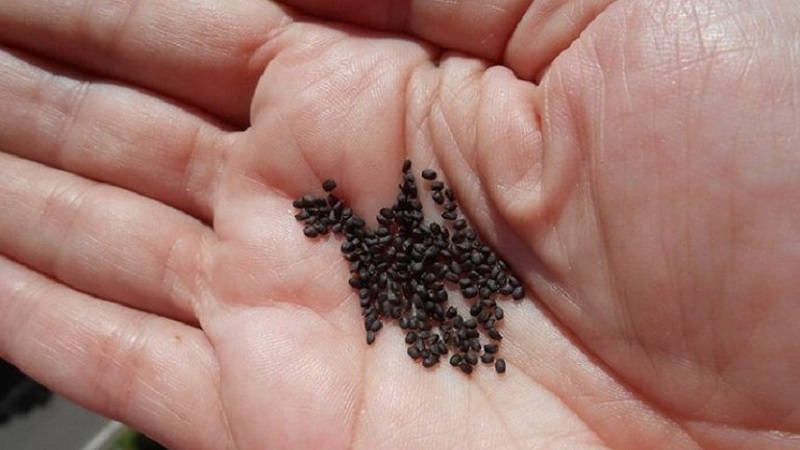
Selection of soil and capacity
Seeds are sown in elongated containers with a depth of 10 cm with the condition of subsequent picking or immediately into individual containers (for example, peat pots, glasses, cut bottles, jars of yogurt or baby food, kefir boxes). A prerequisite is the presence of drainage holes. The minimum volume of the sowing container is 0.2 l, the maximum is 5 l.
For growing seedlings use ready-made, store-bought substrate, soil from the garden or self-prepared soil mixture, consisting of equal parts of peat, garden soil and humus.
Reference. A suitable soil for basil is light, loose and fertile.
In the last two cases, the ground is disinfected in advance.: spilled with a solution of potassium permanganate, frozen for 1 week or roasted in the oven at + 180 ° C for 2 hours. This removes the soil from harmful microorganisms and protects the plants from diseases.
Before sowing, the substrate is watered with a nutrient solution.: 5 g of urea, potassium sulfate, superphosphate and potassium chloride are added to the water.
Sowing
Algorithm of actions:
- At the bottom of the prepared container, a drainage layer of expanded clay, broken brick, perlite or small pebbles 1 cm thick is laid out.
- Fill the container with the substrate.
- Seeds are planted densely, deepening them by 0.5-1 cm.
- Water the crops a little, sprinkle it with earth, tamp it slightly to eliminate the risk of air jams, and water it again.
- Cover the container with plastic wrap or glass to create a greenhouse effect and put it away in a warm place.
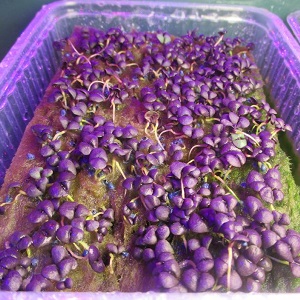 Optimum air temperature for seed germination - + 25 ... + 27 ° C.
Optimum air temperature for seed germination - + 25 ... + 27 ° C.
Subject to temperature conditions seedlings appear in 10-12 (less often - 7-8) days after sowing. After that, the polyethylene or glass is removed, and the container is placed on a lighted windowsill.
Seedlings are regularly watered, focusing on the condition of the soil: Do not allow it to dry out or excessive moisture.
When growing seedlings in a common container after the formation of 1-2 leaves on the seedlings, a pick is carried out - the plants are carefully planted in individual containers.
How to plant purple basil outdoors
Seedlings are transplanted into open ground at the age of 45-60 days, when 4-5 sheets are formed on the sprouts, and only after the establishment of stable warm weather. In most regions of Russia, this time falls on the end of May - beginning of June.
Basil planted in a well-lit place protected from gusty winds and drafts... The culture does not grow well on wet, heavy clay and loamy soil. The soil should be light, loose and nutritious, have good moisture permeability and aeration.
Before planting purple basil, the soil is dug up and fertilized, add 3-5 kg of humus, 25 g of superphosphate and 15 g of potassium salt for each 1 m².
Reference. Good neighbors for culture are legumes, tomatoes and bell peppers; bad neighbors are daikon and radishes.
On the prepared area, rows are formed at a distance of 25-30 cm from each other, make planting recesses in them and place basil seedlings by transferring them. The distance between plants is from 25 cm.
Care
Crop care consists in following basic agrotechnical rules: regular watering, fertilizing, weeding, loosening and protection from diseases and pests.
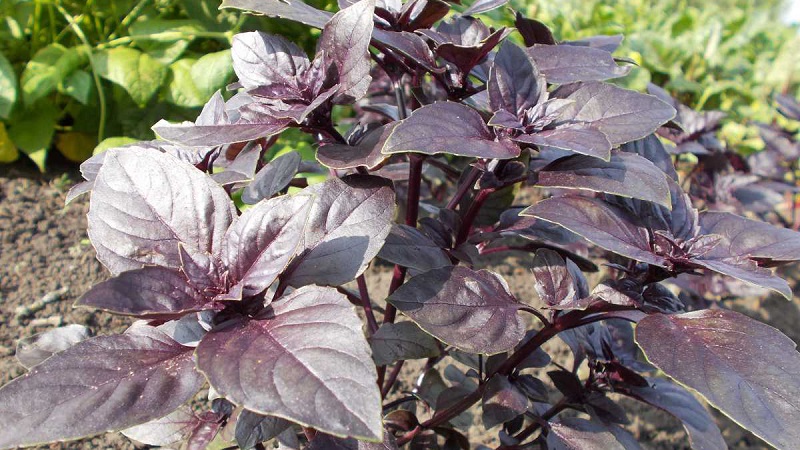
Watering rules
Basil water based on weather conditions: on hot days, the plants are moistened daily, on cloudy - once every 2-3 days. Watering is carried out in the morning, pouring water at room temperature, which has been settled during the day, under the root.
Excessive hydration leads to blackleg development. When the soil dries out, the yield decreases.
Loosening and weeding
The soil is loosened after each watering... This improves the access of oxygen and moisture to the roots, helps to avoid the formation of a dry soil crust.
Several times during the growth of the basil, the soil is weededby removing weeds that take up moisture and nutrients, create a favorable environment for the development of diseases and pests.
Top dressing
For the first time, fertilizers are applied 10-12 days after transplanting plants to the garden (2 tbsp. L. "Nitrofoski" for 12 liters of water). Solution consumption - 3-4 liters per 1 m².
Further, basil is fed every 25-30 daysusing mineral fertilizers with a high nitrogen content, which promotes the growth of green mass.
Topping
In order for the basil to grow correctly, to form a lush bush, to increase the leaf mass, it is pinched - the apical shoots are removed when at least 6 leaves are formed on the plants.
Important! If the plant is going to bloom, pinch it. Basil withers quickly after flowering.
Protection against diseases and pests
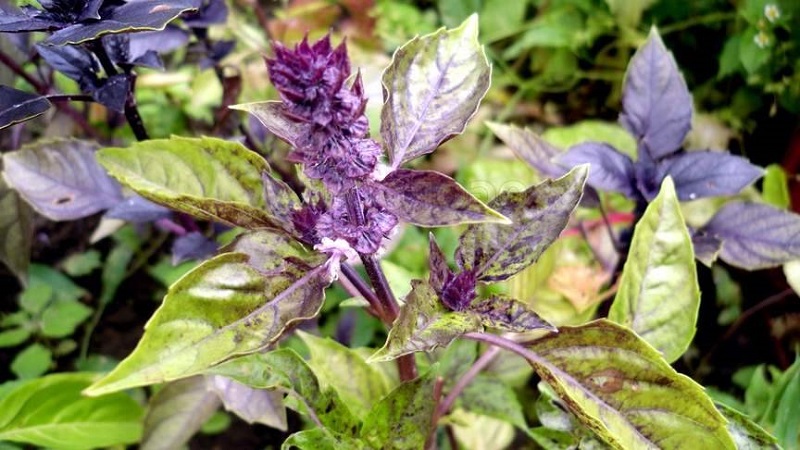
Diseases and pests dangerous for purple basil:
| Disease / pest | Reasons for the appearance | Signs | Treatment |
| Blackleg | High acidity and poor aeration of the soil, excessive watering. | The disease affects the root neck of seedlings, the vessels become soft, blacken and thinner. As a result, the plant turns yellow and dies. | The affected areas are removed, the plants are treated with biological preparations ("Topaz", "Fitosporin"). |
| Fusarium | High temperature against a background of high humidity. | In young plants, the stem becomes thinner and becomes brown, in adults the upper part dries out, the greens wither and die. | At an early stage of the disease, basil is sprayed with an infusion of onion peels (it is poured with boiling water in a ratio of 1: 4 and insisted for a day).
In case of severe damage, the drugs "Teldor", "Sumileks", "Fundazol", "Vectra", "Skor" are used. |
| Gray rot | The fungus lives in the soil, begins to multiply at high humidity. | First, light brown spots appear on the lower leaves, and later on the entire plant. | |
| Rolling the leaves | Damage with black leg, peronosporosis, fusarium, aphids, bedbugs, or inadequate care (weak or excessive watering, high temperature, root damage). | The edges of the leaves are curved inward. | The irrigation and fertilization schedule is being reviewed. The plants are inspected for symptoms of disease or pests and, if necessary, treated accordingly. |
| Yellowing leaves | Depletion of the soil, damage to roots when transplanting seedlings, damage by aphids and bedbugs. | Leaves turn yellow or gray. | Plants are fed with mineral fertilizers containing nitrogen, magnesium and phosphorus. |
| Falling leaves | Lack of moisture in the soil. | The leaves dry up and fall off. | Increase the frequency and abundance of watering. |
| Aphid | Violation of agrotechnical requirements: untimely weeding, thickened plantings, excessive or insufficient watering. | A dark bloom appears on the surface of the leaves, sugary secretions remain, on which soot fungus multiplies. The plant wilts. | Basil is sprayed with decoctions of hot pepper, wormwood, dandelion, tansy, onion or garlic, and soapy water. In advanced cases, use "Bankol", "Akarin", "Aktellik". |
| Spider mite | Dryness, heat, stagnant air. | A thin white web appears on the plant, the leaves dry, black dots are visible on the back. | Basil is treated with soapy water or infusion of tansy, lavender and rosemary in equal proportions. In case of significant lesions, "Akarin" is used. |
To increase the immunity of the culture, 1-2 times a season it is sprayed with the preparations "Immunocytofit", "Novosil", "Obereg".
Interesting on the site:
Sprouting basil for seedlings in a snail
Why purple basil turns green
Basil is a light-loving culture... Purple leaves turn green when there is a lack of sunlight. Daylight hours for a plant should last 14-16 hours.
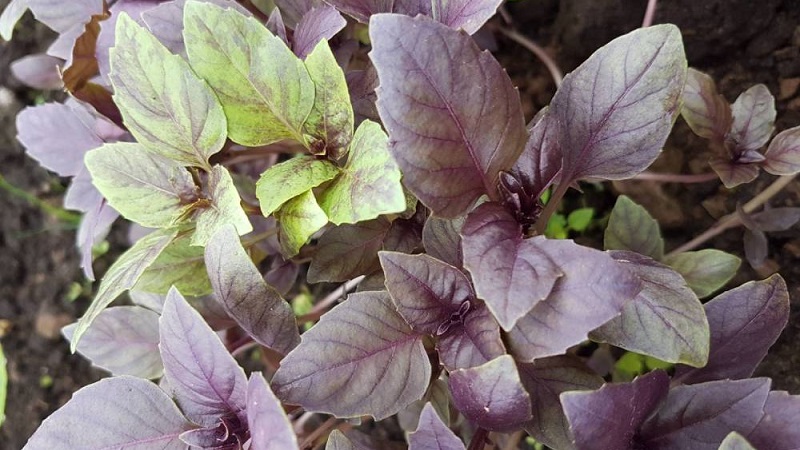
If the leaves and shoots of the basil do not turn purple when growing in a garden, it remains only to wait for sunny days. With their onset, the bushes will return to their previous color.
Important! If the basil grows on the windowsill, and it is cloudy outside or the window is located on the shaded side, the seedlings are taken out to a sunny place or lamps for artificial lighting are installed.
Conclusion
Purple basil is a spicy annual plant that, due to its low resistance to frost, is most often grown in seedlings. The plant is sensitive to soil composition, loves warmth and light, but is unpretentious in care. To obtain a bountiful harvest, it is enough to regularly water the plantings, apply fertilizers and loosen the soil. Fragrant, wholesome leaves are consumed fresh, dried, frozen or preserved.